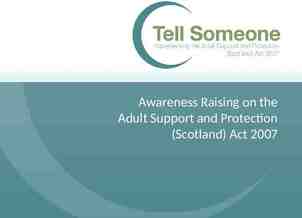Waves “The impetus is much quicker than the water, for it often
23 Slides671.52 KB
Waves “The impetus is much quicker than the water, for it often happens that the wave flees the place of its creation, while the water does not ”
Waves Properties Wave: Transfers energy without transferring matter Types of waves: Mechanical waves: Just waves that require a medium like water, air, ropes etc. 1. Transverse Waves: The particles of the medium vibrate perpendicularly to the direction of the wave
Waves & Energy Transfer 2. Longitudinal Waves: The particles of the medium move parallel to the direction of the wave
Waves & Energy Transfer 3. Surface Waves: A mixture of transverse and longitudinal wave properties Parts of a Wave: Terminology Wave, pulse, amplitude, crest, trough, wavelength, period, frequency, in phase & out of phase
Waves & Energy Transfer Pulse Wave
Waves & Energy Transfer Period (T): The time to complete one cycle (a repeated event) Measured in time units (sec., min. etc) Frequency (f ): The number of cycles per time Measured in Hertz (cycle/sec.) or in r.p.m (revolution per min.) 1 f T 1 and T f
Waves & Energy Transfer Example 1. A bicycle wheel makes 45 revolutions in 18 s. What is the period and frequency? Solution: Time T 18 s # cycles 1 f T 45 0.40 s 1 0.40 2.5 Hz
Waves & Energy Transfer Summing up the properties of waves so far: Wave transfer energy without transferring mass Three types of waves: Transverse Longitudinal Surface waves Wavelength, amplitude and pulse are important quantities in waves Frequency & Period are reciprocals of each other The speed of a wave is set by the medium Waves bounce off fixed-ends and free-ends differently
Wave reflection/refraction diffraction Wave reflection: When a wave bounces off something. Same rules apply, incident is equal to reflection. Refraction: When waves ‘go around’ or ‘between’ something. Like how you can hear someone from around a corner or through an opening. Diffraction: When waves go from deep to shallow hitting the ground as a boundary. This, in water, makes the speed go up and the lambda, which means it gets bigger, like a tsunami
Universal Wave Equation There is a relationship between the speed, wavelength, and frequency of a wave. v λxƒ Where: lambda v speed of the wave in m/s λ wavelength of the wave in m ƒ frequency of the wave in Hz
Universal Wave Equation Example 2: A sound wave produced at a frequency of 670 Hz travels a distance of 1220 m in 3.2 s. a. What is the speed of the sound wave? Solution: v d t 1220 3.2 b. What is the wavelength of the wave? v 381.25 λ ƒ 670 381 m/s 0.569 m
Universal Wave Equation Do Practice Problems #15 -21p. 386
Electromagnetic Radiation Light is a special form of waves that is created by changing electric and magnetic fields. Light waves do not require a “medium” as other waves do and travels at the speed of light (3.00 x 108 m/s) Many different forms of electromagnetic radiation exists. The only difference between the different forms is their fre quency, wavelength and energy.
Radio waves Radiowaves are long wavelength, low frequency and low energy electromagnetic radiation. They also are measured in MHz (10 to the power of 6). The radio in your car picks these up, IE Sun FM is 99.9MHz. They have all the properties of waves; they exhibit wave reflection, diffraction, and refraction. They also show superposition properties and travel at the speed of light.
Wave Behavior Recall that the speed of a mechanical wave depends on the medium it goes through. Examples like water, the depth of the water affects its speed and size. But what happens when waves move from one boundary to another, like to springs joined together (with difference tensions and length)
Types Incident wave: The wave that strikes the boundary. Lets look on page 387. Note it keeps its position when transferring from A to B. IE up stays up or down down. Reflected wave: The wave reflected back after striking the boundary. Side note: When we hit a wall with a wave we come back inverted (Ie pulse is inverted) with almost the same amplitude.
Wave Interference Law of Superposition: When two waves act on a single medium, the two waves will be “added” together to produce a single more complex wave. Wave Superposition Demo
Continued When waves meet they can either be constructive or destructive, dependent on what? Node: When two waves meet and because their amplitude's are opposite we get a flat line, called a node. Antinode: When two waves meet with similar amplitude's and don’t form a flat line, its called an antinode. Lets look at 388.
Wave Interference Standing Waves A special case of wave superposition. It is caused by two waves of identical wavelength traveling in opposite directions along a single medium and page 389. Standing Wave Demo Bridge Collapse – Standing Waves Gone Wild
Sound Stuff Sound waves: Pressure variation that is transmitted though the air, or matter, is a sound wave. See table 15-1 on 405 Side note: Obviously they travel at different speeds in different mediums (ie temp, type etc) Try problems on page 405.
Doppler Effect Doppler effect is the perceived pitch of a sound as 2 objects are moving together or apart, IE a cop siren chasing you down Change in frequency of the sound from a moving object as the object moves past some observer. Show Example of waves un dergoing Doppler Effect
Doppler Effect Sonic Boom A special case of the Doppler effect where the object generating the wave is actually moving faster than the wave. This creates a “bow” wave of a super-wave that follows the moving object Here is all this stuff together Sonic Boom Explanation Video of a Sonic boom in flight.
Doppler Effect Equation ƒd ƒs( (v – vd) / (v – vs)) Where ƒd is the frequency perceived by the detector and ƒs is the frequency perceived by the source. Vd is the velocity of the detector relative to the source and v s is the velocity of source relative to velocity of the wave. I suggest you write down the formula’s on




























